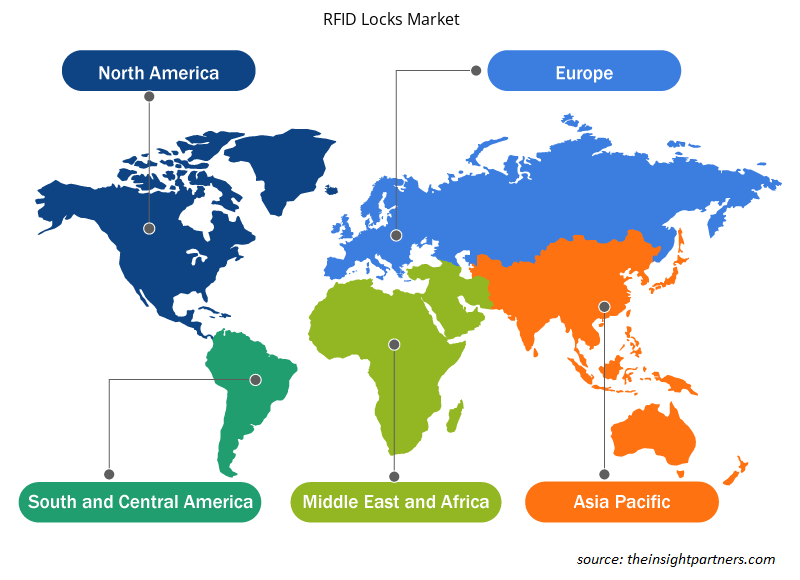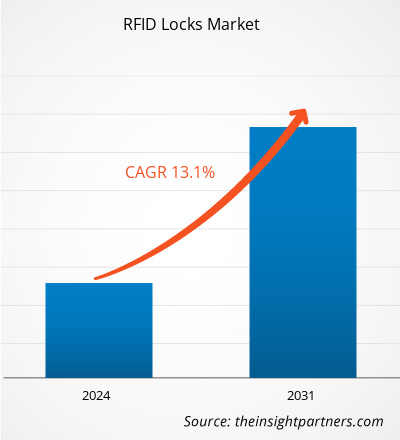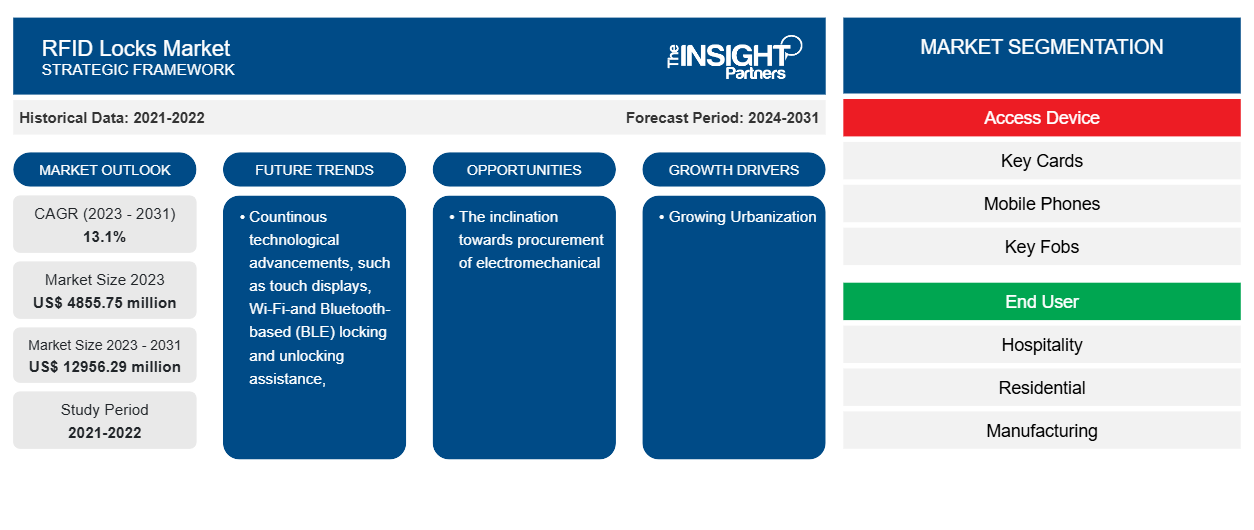Se prevé que el tamaño del mercado de cerraduras RFID alcance los 12.956,29 millones de dólares en 2031, frente a los 4.855,75 millones de dólares en 2023. Se espera que el mercado registre una CAGR del 13,1 % entre 2023 y 2031. Es probable que los avances tecnológicos continuos, como las pantallas táctiles, el bloqueo basado en Wi-Fi y Bluetooth (BLE) y la asistencia para el desbloqueo, sigan siendo un sistema clave para conocer las tendencias del mercado.
Análisis del mercado de cerraduras RFID
Diversos factores, en particular la expansión de las industrias hotelera y turística en todo el mundo, están impulsando la construcción de nuevas estructuras comerciales, incluidos los hoteles. La expansión de las esclusas REID está impulsada directamente por los planes de construir hoteles con más habitaciones y un aumento en la financiación gubernamental para apoyar a la industria hotelera, lo que fomenta la expansión del mercado. Uno de los factores principales que impulsa la demanda de soluciones de acceso mejoradas es la urbanización. La necesidad de soluciones de infraestructura cada vez más complejas y avanzadas está creciendo como resultado de la urbanización que crea más conurbaciones y ciudades con poblaciones de un millón o más. Este factor también está contribuyendo significativamente a la expansión del mercado.
Descripción general de RFID
Una cerradura electrónica que utiliza una tarjeta de radiofrecuencia como llave se denomina cerradura RFID o cerradura de tarjeta de identificación. La antigua tarjeta con contacto necesitaba contacto físico con un lector para abrir una cerradura; con el uso de la tecnología RFID, la tarjeta RFID puede hacerlo sin contacto. La tecnología RFID utiliza ondas electromagnéticas para transmitir señales como parte de su sistema de reconocimiento. Además, debido a su concepto tradicional y su alto costo, el sistema de cerradura RFID no se utiliza para reemplazar las cerraduras mecánicas para uso doméstico. Además, el rendimiento en tiempo real de las cerraduras de puertas RFID puede ser exitoso o no.
Personalice este informe según sus necesidades
Obtendrá personalización en cualquier informe, sin cargo, incluidas partes de este informe o análisis a nivel de país, paquete de datos de Excel, así como también grandes ofertas y descuentos para empresas emergentes y universidades.
-
Obtenga las principales tendencias clave del mercado de este informe.Esta muestra GRATUITA incluirá análisis de datos, desde tendencias del mercado hasta estimaciones y pronósticos.
Impulsores y oportunidades de la tecnología RFID
Urbanización creciente
El crecimiento de la población mundial y el aumento de la migración del campo a la ciudad están impulsando una tendencia al alza en la urbanización. Las naciones menos desarrolladas tienen tasas más lentas de aumento de la población urbana que las naciones altamente desarrolladas. La gente que se desplaza en busca de nuevos empleos, viviendas y espacios comerciales requiere de sistemas de control de acceso y seguridad en los edificios para mantener alejados a los visitantes no deseados. Cada vez más residencias, oficinas, hoteles, almacenes y otros lugares utilizan sistemas de cierre inteligentes. Además, como ya no es necesario llevar una llave o recordar una contraseña, el desarrollo de cerraduras digitales con teclado táctil, cerraduras con huella dactilar , tarjetas REID y otras cerraduras inteligentes ofrece a los consumidores aún más facilidad. Los sectores residencial y comercial están viendo claramente un aumento en las soluciones de seguridad de acceso.
La inclinación hacia la adquisición de productos electromecánicos frente a los sistemas de cierre tradicionales
La preferencia por los productos electromecánicos en lugar de los sistemas de cierre convencionales ha aumentado drásticamente y se prevé que esta tendencia continúe, ofreciendo a los usuarios de sistemas de cierre inteligentes una variedad de opciones de crecimiento. Algunas de las características que ofrece el mercado de cerraduras REID son el diseño ergonómico, el diseño adecuado, el cumplimiento de la ADA, la universalidad y la flexibilidad, lo que aumenta su popularidad en las empresas, en particular en los hoteles. Muchas casas residenciales, apartamentos, escuelas, pequeños edificios comerciales y otros lugares comparables todavía tienen sus puertas exteriores e interiores cerradas con cerraduras tradicionales de llave y pomo. Las soluciones de cierre inteligente se están volviendo más populares entre los propietarios de empresas y propietarios de viviendas como resultado del aumento de la urbanización y la mayor demanda de seguridad. Como resultado, para hacer que sus cerraduras electrónicas sean más inteligentes, los fabricantes de cerraduras están integrando tecnología inteligente en ellas. Por lo tanto, se prevé que la inclinación hacia la adquisición de productos electromecánicos en lugar de sistemas de cierre tradicionales presente nuevas oportunidades para los actores de RFID durante el período de pronóstico.
Análisis de segmentación de informes RFID
Los segmentos clave que contribuyeron a la derivación del análisis RFID son la aplicación y los usuarios finales.
- Según el dispositivo de acceso, la tecnología RFID se segmenta en tarjetas de acceso, teléfonos móviles y llaveros. El segmento de tarjetas de acceso tuvo una mayor participación de mercado en 2023
En función del usuario final, la RFID se segmenta en hotelería, residencial, fabricación, comercio minorista, automotriz, aeroespacial y defensa, gobierno y servicios públicos, y otros.
Análisis de la cuota de RFID por geografía
El alcance geográfico del informe RFID se divide principalmente en cinco regiones: América del Norte, Asia Pacífico, Europa, Oriente Medio y África, y América del Sur/América del Sur y Central. Las tecnologías de seguridad avanzadas, como las cerraduras de puertas con RFID y NFC, son cada vez más conocidas en la región APAC, especialmente para aplicaciones de seguridad para el hogar. Además, las principales empresas están invirtiendo en países en desarrollo como China y Japón, lo que está alimentando la necesidad de soluciones asequibles que faciliten un control de acceso eficaz . Durante el período de pronóstico, se prevé que el mercado de la región APAC aumente como resultado de esta inversión y el uso cada vez mayor de soluciones de seguridad avanzadas.
Alcance del informe RFID
Noticias y desarrollos recientes sobre RFID
La RFID se evalúa mediante la recopilación de datos cualitativos y cuantitativos a partir de investigaciones primarias y secundarias, que incluyen importantes publicaciones corporativas, datos de asociaciones y bases de datos. A continuación, se incluye una lista de novedades en el mercado de los trastornos del habla y el lenguaje y sus estrategias:
- En agosto de 2022, Kalahari Resorts & Conventions adoptó la tecnología de cerraduras RFID y el sistema de gestión de control de acceso Visionline de Assa Abloy Global Solutions. Con solo una pulsera RFID o una tarjeta de acceso, los huéspedes pueden acceder a su habitación, a otros complejos turísticos y comprar artículos sin tener que llevar consigo tarjetas de crédito personales o dinero en efectivo.
(Fuente: Kalahari Resorts & Conventions, comunicado de prensa)
- En septiembre de 2021, Honeywell adquirió Performix Inc., una empresa privada. La adquisición se basa en la estrategia de Honeywell de crear la plataforma de software integrada líder en el mundo para clientes de la industria de las ciencias biológicas que se esfuerzan por lograr un cumplimiento más rápido, una mayor confiabilidad y un mayor volumen de producción.
(Fuente: Honeywell, Nota de prensa)
Perspectivas regionales del mercado de cerraduras RFID
Los analistas de Insight Partners explicaron en detalle las tendencias y los factores regionales que influyen en el mercado de cerraduras RFID durante el período de pronóstico. Esta sección también analiza los segmentos y la geografía del mercado de cerraduras RFID en América del Norte, Europa, Asia Pacífico, Oriente Medio y África, y América del Sur y Central.

- Obtenga datos regionales específicos para el mercado de cerraduras RFID
Alcance del informe de mercado de cerraduras RFID
| Atributo del informe | Detalles |
|---|---|
| Tamaño del mercado en 2023 | US$ 4.855,75 millones |
| Tamaño del mercado en 2031 | US$ 12.956,29 millones |
| CAGR global (2023 - 2031) | 13,1% |
| Datos históricos | 2021-2022 |
| Período de pronóstico | 2024-2031 |
| Segmentos cubiertos |
Por dispositivo de acceso
|
| Regiones y países cubiertos |
América del norte
|
| Líderes del mercado y perfiles de empresas clave |
|
Densidad de actores del mercado de cerraduras RFID: comprensión de su impacto en la dinámica empresarial
El mercado de cerraduras RFID está creciendo rápidamente, impulsado por la creciente demanda de los usuarios finales debido a factores como la evolución de las preferencias de los consumidores, los avances tecnológicos y una mayor conciencia de los beneficios del producto. A medida que aumenta la demanda, las empresas amplían sus ofertas, innovan para satisfacer las necesidades de los consumidores y aprovechan las tendencias emergentes, lo que impulsa aún más el crecimiento del mercado.
La densidad de actores del mercado se refiere a la distribución de las empresas o firmas que operan dentro de un mercado o industria en particular. Indica cuántos competidores (actores del mercado) están presentes en un espacio de mercado determinado en relación con su tamaño o valor total de mercado.
Las principales empresas que operan en el mercado de cerraduras RFID son:
- Assa Abloy AB
- Compañía Bai Fu Ltd.
- Digilock (Gente de Seguridad Inc.)
- Grupo Dormakaba
- Euro-locks SA NV (Grupo Lowe y Fletcher)
- Compañía manufacturera Godrej y Boyce Ltd.
Descargo de responsabilidad : Las empresas enumeradas anteriormente no están clasificadas en ningún orden particular.

- Obtenga una descripción general de los principales actores clave del mercado de cerraduras RFID
Informe sobre el mercado de cerraduras RFID: cobertura y resultados
El informe “Tamaño y pronóstico del mercado de cerraduras RFID (2021-2031)” proporciona un análisis detallado del mercado que cubre las siguientes áreas:
- Tamaño del mercado y pronóstico a nivel global, regional y nacional para todos los segmentos clave del mercado cubiertos bajo el alcance
- Dinámica del mercado, como impulsores, restricciones y oportunidades clave
- Principales tendencias futuras
- Análisis detallado de las cinco fuerzas de Porter y PEST y FODA
- Análisis del mercado global y regional que cubre las tendencias clave del mercado, los principales actores, las regulaciones y los desarrollos recientes del mercado.
- Análisis del panorama de la industria y de la competencia que abarca la concentración del mercado, el análisis de mapas de calor, los actores destacados y los desarrollos recientes
- Perfiles detallados de empresas
- Análisis histórico (2 años), año base, pronóstico (7 años) con CAGR
- Análisis PEST y FODA
- Tamaño del mercado, valor/volumen: global, regional y nacional
- Industria y panorama competitivo
- Conjunto de datos de Excel
Informes recientes
Informes relacionados
Testimonios
Razón para comprar
- Toma de decisiones informada
- Comprensión de la dinámica del mercado
- Análisis competitivo
- Información sobre clientes
- Pronósticos del mercado
- Mitigación de riesgos
- Planificación estratégica
- Justificación de la inversión
- Identificación de mercados emergentes
- Mejora de las estrategias de marketing
- Impulso de la eficiencia operativa
- Alineación con las tendencias regulatorias























 Obtenga una muestra gratuita para - Mercado de cerraduras RFID
Obtenga una muestra gratuita para - Mercado de cerraduras RFID